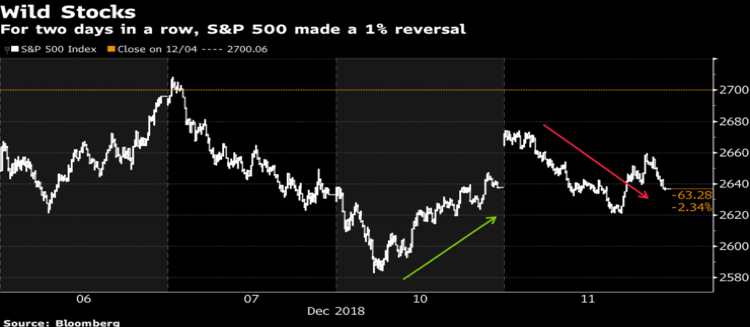Following our initial assessment of next year’s prospects, we discuss below some reasons that make us believe next year may be better than 2018.
It seems that until this past summer, market sell-offs were followed by buying tactics (buying the dip). Recently the tactic seems to have reversed: investors seem to be selling temporary rallies. We attribute such change in tactics mainly to the changing tipping scale, that is, rising uncertainty to which a risk score cannot be assigned. Such uncertainty relates to the possibility that the trade disputes (primarily between the US and China) evolve into a trade war, the peaking in the rate of earnings’ growth, potential slowdown in the economy, the Fed’s rate increases, the rising dollar which hurts emerging markets, a housing slowdown in the States, and the possibility of declining business and consumer sentiment.
The tipping of the scale towards rising uncertainty could easily be seen in the last few days. On Monday the S&P 500 erased a loss of close to 2%, while on Tuesday it wiped out a gain of almost 1.5%. In the last quarter there have been at least six sessions in which equities completely reversed intraday moves of at least 1%. The graph below demonstrates this tipping towards uncertainty.

The market nervousness and the flip flops for the reasons described above seem to be calming down based on market reactions yesterday. Some decisive steps taken by China indicate willingness to compromise, and it is our assessment that given the latest developments a trade truce may be extended for all of 2019. Furthermore, although traditionally we have been very cautious about Chinese stocks, we believe – based on the latest undercurrents and the significant selloff in Chinese stocks – that the Chinese authorities will flood the market with liquidity in 2019, and thus some well-known Chinese names (especially the ones that are internet related) that have lost over 25% of their value in 2018 may be worth looking into for potential buys.
Furthermore, we believe that the British pound is undervalued and thus some position in sterling and/or even in the FTSE 250 could be considered. In addition, beaten-down sectors in the US (such as financials) may do better than the overall market in 2019, while others that have done fairly well in 2018 (such as heathcare) may also continue to outperform the market.
We understand that some technical indicators (such as the formation of a death cross where the 50-day moving average crosses the 200-day moving average, or the head and shoulder pattern) may signal a market downturn, especially if combined with higher trading volumes and the temporary inversion of the yield curve (where short term Treasuries yield more than longer term ones). However, as we try to assess 2019 we could say the following:
* Following an index-investing approach in 2019 may not be wise. That does not necessarily mean that picking only individual stocks would be the best strategy, but it should imply that some sectors will outperform the market, and particular stocks within those sectors may do better than the sector itself.
* We expect a reversal of fortunes in Chinese equities, especially for those companies that are internet-based.
* Emerging markets should perform better, and we expect to erase some of the significant losses they suffered in 2018. However, caution is needed as to the countries chosen for potential reversal given that some of them are susceptible to more losses.
* A dollar cost average approach is highly recommended for any moves decided.
* Dividend seeking strategies could act as buffers in a volatile environment, especially if the Fed slows down its rate hikes (as we have been pointing out since last September).
* Given the macro-fundamentals (economic growth, price stability, high employment levels, healthy earnings, relative healthy balance sheets, consumer spending, etc.) we are of the opinion that equity markets may perform better in 2019 relative to their dismal performance this year, especially in the second half of 2019 if the dollar starts weakening (see https://blacksummitfg.com/the-financial-ecosystem-and-the-dollar-trajectory-international-reserves-the-eurodollar-market-and-fiscal-policies/).
* The late stage of the economic cycle is usually followed by the beginning of the upswing in the commodities cycle, and thus commodities could be seriously considered for 2019.
* Our restrained optimism for 2019 does not cancel out our concerns about the inverted financial pyramid the financial ecosystem has created with derivatives and debts threatening to unravel an apocalypse. However, we do not see such unraveling taking place. On the contrary we see that 2019 may bring us closer to igniting the historical engine of finance.
